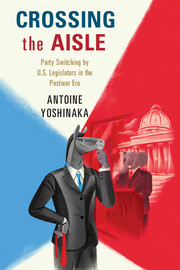Book contents
- Frontmatter
- Dedication
- Contents
- List of Tables
- List of Figures
- Acknowledgments
- PART I
- PART II
- PART III
- PART IV
- 7 Behind the Scenes: The Role of Party Leaders, Rank-and-File Members, and Former Party Switchers
- 8 A “Real-Time” Look into the Decision to Cross the Aisle
- 9 Conclusion
- Appendix A Excluded “Pseudo-Switchers”
- Appendix B Details about Elite Interviews
- Appendix C Data Sources for Chapter 3
- Appendix D Data Sources for Chapter 4
- Appendix E Data Sources for Chapter 5
- Appendix F Data Sources for Chapter 6
- References
- Index
7 - Behind the Scenes: The Role of Party Leaders, Rank-and-File Members, and Former Party Switchers
from PART IV
Published online by Cambridge University Press: 05 December 2015
- Frontmatter
- Dedication
- Contents
- List of Tables
- List of Figures
- Acknowledgments
- PART I
- PART II
- PART III
- PART IV
- 7 Behind the Scenes: The Role of Party Leaders, Rank-and-File Members, and Former Party Switchers
- 8 A “Real-Time” Look into the Decision to Cross the Aisle
- 9 Conclusion
- Appendix A Excluded “Pseudo-Switchers”
- Appendix B Details about Elite Interviews
- Appendix C Data Sources for Chapter 3
- Appendix D Data Sources for Chapter 4
- Appendix E Data Sources for Chapter 5
- Appendix F Data Sources for Chapter 6
- References
- Index
Summary
I had a Republican colleague – he was very powerful – call me and ask me to [switch parties]. And he told me that I wouldn't have to worry about money. I always had trouble raising money, I was never good at it…. But this person told me I would not have to worry about raising money.
– Interview with Congressperson I (Democratic nonswitcher)The story so far has been one of political ambition, the electoral costs and institutional benefits of switching parties, and the willingness of legislators to take a risk by jumping to the other side. Switching parties is a personal decision made after weeks, months, or even years of serious consideration by individual legislators who must ultimately decide what is in their best interest; the proverbial buck stops with them. The decision, however, is not made in a vacuum. Rather, the party switcher is part of a larger social system, namely the legislature, where such a career-defining moment is not lost on party leaders or rank-and-file colleagues. A member's decision to switch parties will affect those actors as well, and in turn, those actors can influence a legislator's thinking. Instead of being passive bystanders, it may be reasonable to surmise that individuals such as party leaders will play an active role in legislators’ decision to switch parties. The next two chapters provide a glimpse into those dynamics with evidence from semistructured interviews with elected officials and their staff members.
In this chapter, I turn to the behavior of party leaders, rank-and-file members, and former party switchers, and ask the following questions: Do party leaders help lower the costs of party switching? To what extent do other members interact with switchers or potential switchers, both before and after a party switch? What goes on “behind the scenes” that, unlike committee assignments or electoral returns, may not be readily observable? And how does this advance our theoretical understanding of elite decision making generally and party switching specifically? My contention is that answers to these questions will provide even more depth to our understanding of legislators’ decision to switch parties.
- Type
- Chapter
- Information
- Crossing the AisleParty Switching by US Legislators in the Postwar Era, pp. 181 - 206Publisher: Cambridge University PressPrint publication year: 2015



